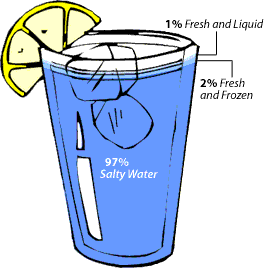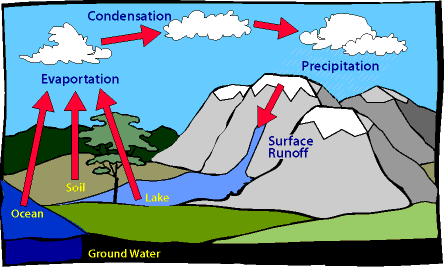
Hydrosphere:
Overview
Three-quarters
of Earth is covered by water. The area in which all of Earth's water exists
is called the hydrosphere. This sphere
appears to make Earth unique among bodies in the solar system. The hydrosphere
enables this planet to support life.
 However,
not all water on Earth can support life. Ninety-seven percent of the water
on Earth is salty. Most organisms cannot drink saltwater. Most living
things depend on freshwater for survival. Only three percent of all Earth's
water is freshwater. Sixty-seven percent of the world's freshwater is
frozen in polar icecaps and glaciers. That makes it unavailable for use
by most species. This leaves only thirty-three percent of the world' s
freshwater--or approximately 1% of all the water on Earth--available to
sustain life.
However,
not all water on Earth can support life. Ninety-seven percent of the water
on Earth is salty. Most organisms cannot drink saltwater. Most living
things depend on freshwater for survival. Only three percent of all Earth's
water is freshwater. Sixty-seven percent of the world's freshwater is
frozen in polar icecaps and glaciers. That makes it unavailable for use
by most species. This leaves only thirty-three percent of the world' s
freshwater--or approximately 1% of all the water on Earth--available to
sustain life.
Water in the hydrosphere can exist as a solid (ice), a liquid (water), or a gas (water vapor). It is constantly changing among these three forms, or phases. Water moves around Earth as it changes form. The movement of water occurs in a group of repeating events. The group of repeating events is called the water cycle or hydrologic cycle. It is diagramed in the figure below. Glass image © 1999 -www.arttoday.com

Heat from the sun causes water in oceans, lakes, swamps, rivers, plants, and even our own bodies to evaporate into water vapor. Water vapor in the atmosphere forms clouds as it cools and condenses. Clouds are collections of millions of tiny droplets of water. When these tiny droplets of water cool, they form larger drops of water. When the drops of water become too heavy to stay in the cloud, they fall to the Earth as precipitation. Rain, snow, sleet, and hail are all forms of precipitation. The form of precipitation that falls depends on the temperature of the air. During warm temperatures, precipitation falls in the form of water (rain). During cold temperatures, precipitation falls in the form of ice (snow). Water from precipitation flows across the surface of the land into lakes, streams, and oceans. Some of the water enters the ground. Plants absorb water from the ground through their roots. The water eventually evaporates. And so the water cycle continues.
Overview
..|.. Importance
of Clean Freshwater ..|..
Studying the Hydrosphere Home
..|..
Teacher Pages
..|..
Modules
& Activities
Glossary .|.
Related Links
.|..
References
..|..
PBL Model
.|
HTML code by Chris Kreger
Maintained by ETE Team
Last updated November 10, 2004
Some images © 2004 www.clipart.com
Privacy Statement and Copyright © 1997-2004 by Wheeling Jesuit University/NASA-supported Classroom of the Future. All rights reserved.
Center for Educational Technologies, Circuit Board/Apple graphic logo, and COTF Classroom of the Future logo are registered trademarks of Wheeling Jesuit University.
